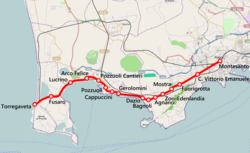Cumana railway
| Cumana railway | |||
|---|---|---|---|
| Overview | |||
| Type | Commuter rail | ||
| Status | in use | ||
| Locale | Campania, Italy | ||
| Operation | |||
| Opened | 1 July 1889 | ||
| Operator(s) | EAV | ||
| Technical | |||
| Line length | 19.81 km (12.31 mi) | ||
| Track gauge | 1,435 mm (4 ft 8 1⁄2 in) standard gauge | ||
| Electrification | 3 kV DC | ||
|
|||
The Cumana railway (Italian: Ferrovia Cumana) is a commuter railway in Campania, southern Italy, connecting Naples by two separate routes with Torregaveta, near Cuma in the town of Bacoli (about 15 km west of Naples). It passes through Pozzuoli and the volcanic Campi Flegrei area. The line was built and run by the Società per le Ferrovie Napoletane (the Neapolitan Railway Company), founded in 1883, and is now operated by the EAV company.
The line was opened on 1 July 1889 by the Società per le Ferrovie Napoletane; the route follows the coast for about 20 km from the main terminal in the populous downtown area of Montesanto to Torregaveta via the stations of Corso Vittorio Emanuele, Fuorigrotta, Mostra, Bagnoli, Pozzuoli, Arco Felice, Baia and Fusaro.
In 1927 the railway, because of the increasing commuter traffic, was electrified with a 1,2 kV DC overhead line.
In 1940 the section in the neighbourhood of Fuorigrotta was reconstructed and put underground, with the new stations of Fuorigrotta and Mostra built in rational architecture style. In the same year the SFN give the line to the SEPSA, a branch of the EAV.
In 1962 the electrification was elevated from 1,2 to 3 kV, and the new ET 100 EMUs were put into service.
The increasing traffic has made it necessary to double the track, beginning in 1975. The doubling of the Montesanto-Bagnoli (8.5 km) and Arco Felice-Torregaveta (5.9 km) sections have been completed and work on the remaining section (Bagnoli-Arco Felice (5.7 km)) is well under way.
Trains travel every 20 minutes.
...
Wikipedia

